Author: Lisa Town
Mr. Rogers Green Neighborhood
Recently, I happened to be flipping through the channels and I happened upon an old episode of Mr. Rogers Neighborhood, one that originally aired on April 16, 1999, and yet it looked so very old. I would’ve kept going but it had just started and I saw the title of this particular episode “Mr. Rogers Talks About the Enivornment”. And it was in fact one episode out of a whole weeks theme on caring for the environment and taking a look at how children can work together with their parents to help care for our planet.
The episode started out by Mr. Rogers receiving a greeting card and talking about how to convert a used greeting card into a new greeting card that you can send it to someone else. You simply tear carefully along the fold of the card to remove the top, thus making a post card type greeting card. Mr. Rogers even explored ways to reuse items around the house, including turning old items into toys and games.
Then Mr. McFeely stopped by and discussed a little bit about trash, the overflowing dumps and his important message of “Think before you throw anything away”. He then sped off on his bike in his “own effort to help save the environment”.
In the world of make believe several things happened including King Friday accidentally making 200 copies of something he only needed 2 copies of which made for a discussion of what to do with the other 198 pieces of paper. Mr. McFeely showed up and told them that they should save the paper and that they needed to be careful because the neighborhood garbage dump is getting full. He then gave Bob Dog the job of going through some trash bins to see what he could save.
Messages abounded of too much garbage, the dump being full and people saying things like “the garbage dump never gets full”. But then when people visited the dump there was surprise over the amount of garbage. After an initial discussion of what to do, they quickly decided the solution was to find another dump. But of course, that was not the solution at all since this was a problem everyone was facing. The group needed to think a little harder.
The message was that you just don’t think about things until it’s not available anymore and you have to think of new solutions, get creative and really learn to use your resources wisely. In looking beyond Mr. Rogers traditional message of loving yourself and others, he adds the message of loving your environment and how learning more about the world can help you learn more about yourself.
These are indeed good words to live by….and great things to be teaching children. As it turns out, the sweatered man was actually a little progressive.
February Photoshop Tutorial: Blend Mode Breakdown
I often see people painstakingly cutting out backgrounds that don’t need to be cut simply because they don’t fully understand the power of Blend Modes. I remember the day that I starting fully using these crazy things and it was a lot like the day I discovered Photoshop and the whole concept of layers…the amazing possibilities just blew me away.
If you have never used Blend Modes or you’ve played around with them and thought that they were interesting but you didn’t really how to control them, this one’s for you. I’ll try to break it down into some simple terms and point out the most useful ones in our type of rendering work with some examples.
First, here are the Blend Modes, grouped into their blending categories:
Normal (default setting, no blending)
Dissolve
These blend modes deal with Darkening
Darken
Multiply (*mode of choice for eliminating white backgrounds)
Color Burn
Linear Burn
These blend modes deal with Lightening
Lighten
Screen
Color Dodge
Linear Dodge
These blend modes deal with Light and Contrast
Overlay
Soft Light
Hard Light
Vivid Light
Linear Light
Pin Light
Hard Mix
These blend modes deal are Comparative, inverting the base color
Difference
Exclusion
These blend modes deal with Color
Hue
Saturation
Color
Luminosity
For a full description of how each one works, I’ve put together a pdf document which you can download. It’s just too much text for this tutorial. And who wants to read all that text? Let’s get down to some tutorialin’.
First, download this file so that you can follow along.
Let’s look at why we need blend modes and why simply cropping out an image or using transparency won’t cut it when it in certain situations. In this first example, let’s try to put a complicated image over a textured background with no cropping and no transparency but still allow the background to show through and have the image look like it’s meant to be there. In the spirit of February being the month of love, let’s put a smooch on a piece of wood. I grabbed two images, one of a heavily grained wood texture and another of a lipstick kiss.
When I put the kiss layer on top of the wood layer, this is the result:
So there’s that darn white background in the way. If you wanted to cut that kiss out, how would you do it? There’s really no good option is there? That’s where the magical blend modes come in. Take a look at your layers palette, which should look like the below image, and notice the area circled in red. This is where the Blend Modes are.
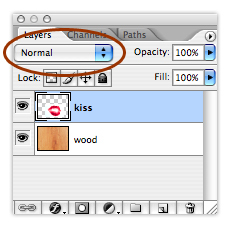
There are actually several options available to you. Normal is the default setting and actually means that no blending is applied. When you click on the drop down menu there circled in red in the above image, the full list of options comes into view.

If you just simply want to get the white out, in fact multiply would be a good first choice. But when I do that, I notice that the kiss looks a little dark and unnatural. Since the point of multiply is to multiply the base color with the blend color the color will always be darks, thus the reason white always disappears allowing other colors to show through. But in this case, I don’t really want the kiss to look any darker, I just want the white to go away and the underlying grain to show through.
So what other blend modes can I choose? I have chosen to use Color Burn because it will take away the white and allow the grain to show through but since color applied to light areas remains unchanged, the kiss has less of a darkening effect over the light wood. Here’s the result using color burn:
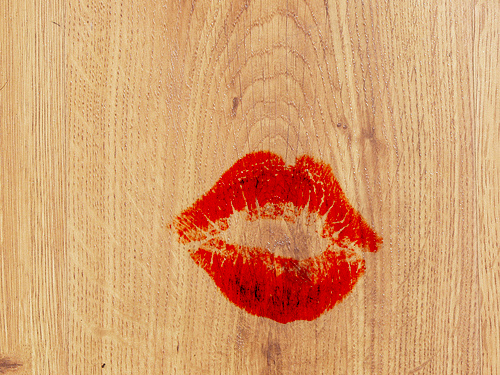
With the idea of trying to get the white out, let’s look at a quickie that you will instantly take back and use at work. As designers, something we do ALL the time is draw something by hand or in the computer and then inevitably want to scan it or save it and it has a white background and then wish to superimpose it on top of something whether it’s an existing site image, an aerial or even another scan. So as an example, I grabbed a random aerial to use as a background and then some computer drawn topography. The original images are below, with a slight overlap to show that there is a white background that won’t let the aerial show through:
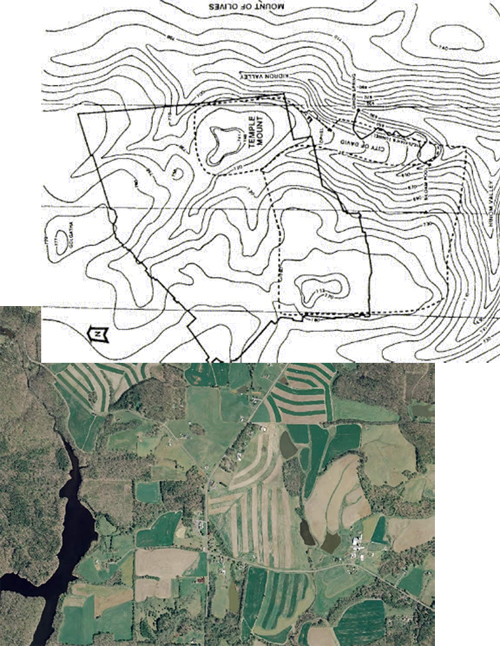
With both images on separate layers, put the topography layer on the top and then change the Blend Mode to Multiply. This mode eliminates the white, allow the contours to look like they are right on the aerial image, like below. This can be used for any scan or image that you want to eliminate the white.

Now let’s look at making an object appear inside of something. A bottle is a great one to practice with because of all the complicated reflections on the glass. So I have a bottle and a santa figure, how might I make the santa look like it’s actually inside the bottle?
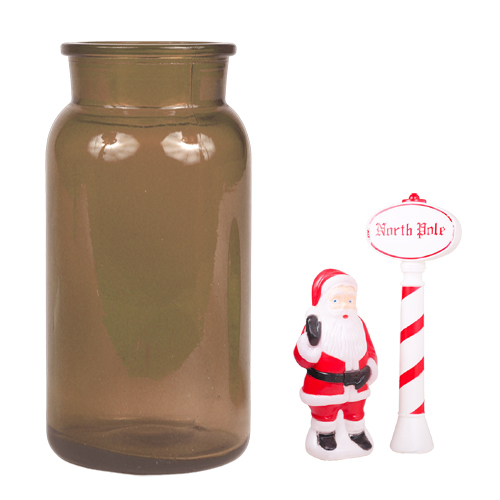
So I bet your first thinking that you have one layer of the bottle behind the santa and one in front and then you lower the opacity to see the santa, right? Well let’s see what that looks like….
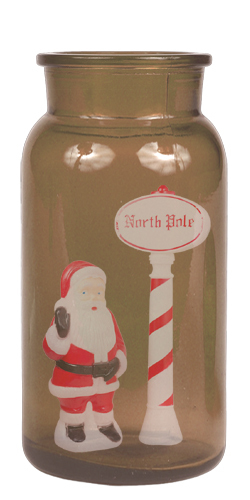
That’s not too bad but the santa looks really faded, like the glass is really dirty. The glass should be clear and have a shiny look to them with crisper reflections. Let’s see what this could look like utilizing a Blend Mode:
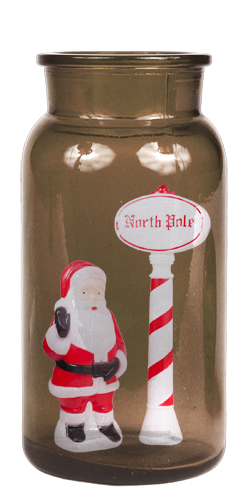
It looks a bit more convincing doesn’t it? Now let’s break it down…
Start with the bottle, then make a copy. The original bottle is a deep brownish color but with the copy, which will ultimately just be displaying the reflections, doesn’t need to have any color so that the blending can just focus on areas of light and dark.
To get the color out of the bottle just desaturate it. Image > Adjustment > Desaturate. Note: never change the image mode when trying to make something grayscale, always desaturate it and leave the mode in RGB. Your top most bottle layer should now look like the gray bottle below.
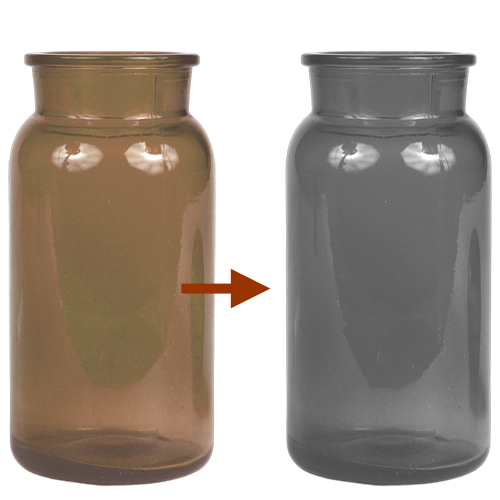
You should have two layers…the original brown bottle and the gray bottle. Now place any object in between those two layers. In my case, I’m using the santa. And just to complete the look, I’ve painted in a little bit of white around the base and a few dots within the bottle to look like snow. And the key to this whole look is how to blend the top most bottle layer.
Since the goal here is to reproduce the glass surface over the object inside, which really means the lights and darks in the reflections, then we are focusing on light. So that means we will want to use one of the Blend Modes that deals with Light and Contrast. Take a look at the different modes in the Light section. I chose to use the Hard Light mode because I didn’t want anything to look too fuzzy and warm, I just wanted it focus on the lights and darks and how it blended with the object below. Here’s the final image:

Lastly, just for fun I will share an image I made while teaching a Photoshop workshop in Mexico that also uses a bottle. This image was created from many different images to aid in the discussion of the art of selections and blending. Plus I love Absolut ads and just wanted to have some fun with making my own. This image definitely could not have been completed without the use of several different blend modes.

So that was only the tip of the iceburg on Blend Modes but the best thing to remember is that chances are, if the task of cropping something seems too difficult or even impossible, chances are using a Blend Mode is the key. Stay tuned for the March Photoshop Tutorial where I continue on this discussion of Blend Modes!
- 1
- 2


